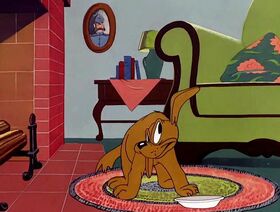Deprecated
We have moved to portable infoboxes using the new Template:Shorts
Please do not use this template anymore. It is left here for reference purposes.
| Fresh Airedale | |||||||||||||||||||||||||||||||||||||||||||||
| |||||||||||||||||||||||||||||||||||||||||||||
|
Fresh Airedale is a 1945 Merrie Melodies short short planned by Bob Clampett but was reworked and finished by Chuck Jones.
Plot
In his master's eyes, "good old Shep" is the perfect dog, but the cat knows he's really a two-faced mutt who can be bought off with a bone by a burglar, and then take credit for it when the cat chases the crook off. But then Shep becomes obsessed with a newspaper story proclaiming a real canine hero the nation's "No. 1 Dog." He wakes up and travels a long distance to the hero's house, with the cat right behind him. Before Shep can attack the terrier, the cat pulls out a giant club and knocks him into the water. The terrier rescues Shep, who quickly scoops the terrier up in his mouth, claiming that he drowned. Shep is celebrated, much to the anger of the cat.
Availability
- (1992) Laserdisc - The Golden Age of Looney Tunes, Volume 3, Side 3
- (1999) VHS - Looney Tunes: The Collectors Edition Volume 10: Canine Corps (1995 Turner dubbed version)
- (2008) DVD - Looney Tunes Golden Collection: Volume 6, Disc 4. (Blue Ribbon reissue with optional commentary by Greg Ford)
Notes
- According to the DVD commentary, this cartoon was originally called "For He's A Jolly Good Fala", about a dog who tries to kidnap President Franklin Delano Roosevelt's dog. However, President Roosevelt died at the time the cartoon was made, so all the references that the dog belonged to the former President were changed to the dog being a national hero.
- Also accordingly, the short was originally planned to be directed by Bob Clampett while having President Franklin voiced by Stan Freberg in the short, but since his death at the time, as well as Clampett's departure from Warner Bros., the short was heavily reworked and finished by Chuck Jones, with all of Stan Fredberg's lines being completely removed from the short. [1] [2]
- In the Turner "dubbed version" print as seen on current TV airings (including Cartoon Network and Boomerang) there appears to be two additional lines of dialogue from Shep's master that is not heard in either the older a.a.p. prints or the restored DVD print. [3] [4] [5]
- When Shep's master places his steak for dinner, he says it was "140 points to get that roast, but it was worth it." (Note: the "points" refer to food rationing points from World War II back when the cartoon was created).
- As Shep's owner leaves for his job (before Shep assists a burglar in robbing the house), he says goodbye to him "I have to build some battleships for Uncle Sammy."
- These lines of dialogue were very likely to come from its original circa-1945 (pre-)release print as it was produced during World War II, and it was unknown when those two lines of dialogue were deleted, either before its original theatrical release or its Blue Ribbon reissue as the cartoon was originally released in theaters when World War II had ended. When this cartoon was sold to a.a.p. for television distribution, both Blue Ribbon reissue print soundtracks of this cartoon containing with and without the wartime references were included in the package of pre-1948 Looney Tunes shorts and have been stored separately in the vaults of a.a.p. and its successor companies, hence explaining how these two additional lines of dialogue could've possibly turned up in the cartoon's Turner "dubbed version".
- Foreign language dubs of this cartoon have included those aforementioned additional two lines of dialogue as mentioned above when airing this cartoon as a as Turner "dubbed version. [6]
- The a.a.p. print seen on Laserdisc and pre-1995 TV airings appears to have very badly faded colors with extremely horrible color corrections (perhaps worse than other a.a.p. prints, with a color palette that looks very worn-out and decaying) due to the print sourced from a 16mm "dupe" negative which was in a very poor condition, considering that a.a.p. and its successor companies never had access to the original negatives of the pre-1948 cartoons which were stored in the WB vaults at the time.[7] Like it's future restored DVD print, the a.a.p. print of this cartoon does not have any additional WWII-related dialogue as heard in the cartoon's Turner "dubbed version" (see the previous note above for more details).
External Links
- ↑ http://www.whataboutthad.com/2013/03/06/the-clampett-freberg-lorre-connection/
- ↑ https://cartoonresearch.com/index.php/animation-anecdotes-136/
- ↑ https://web.archive.org/web/20011109072502/http://www.megalink.net:80/~cooke/looney/update20.html
- ↑ https://vk.com/videos-5286402?z=video-5286402_158887017%2Fclub5286402%2Fpl_-5286402_-2
- ↑ https://www.b98.tv/video/fresh-airedale/)
- ↑ http://chomikuj.pl/izebel/Filmy/Animowane/Seriale/Z/Zwariowane+Melodie/Pojedyncze+kresk*c3*b3wki/059.Zwariowane+Melodie+-+Wierny+pies,1646428506.rmvb(video))
- ↑ https://vk.com/search?c%5Bq%5D=fresh%20airedale&c%5Bsection%5D=auto&z=video-32259070_161801245)


